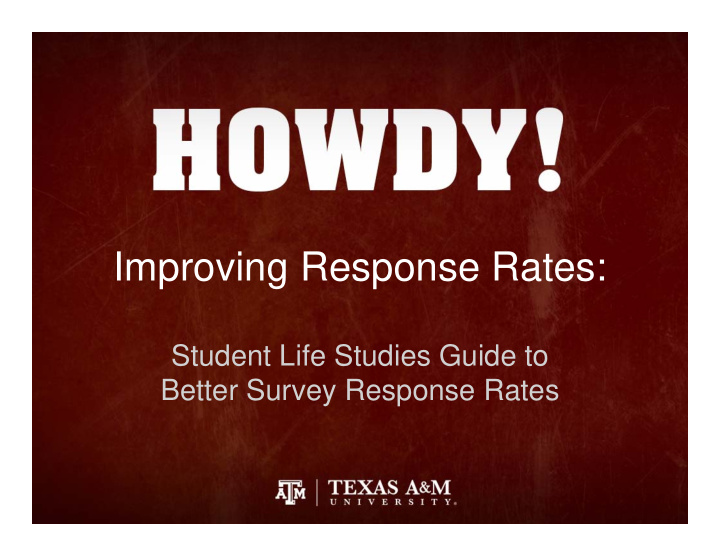



Improving Response Rates: Student Life Studies Guide to Better Survey Response Rates
Survey Response Rate Overview • Survey Length • Follow up Reminders • Research Affiliation • Issue Salience • Group Cohesiveness • Pre-notification • Compensation/Incentives • Non-Response Bias
Survey Length Question Number Response Rate Q1 68/0 Q41 57/11 Q44 56/12 Q57 52/16 Q63 51/17 Q68 49/19 Q73 46/22 Q83 50/18 Q89 51/17 Q95 49/19 Q100 50/18
Follow Up Reminders Overall Students Staff Faculty/ Other Overall 23.9% 21.6 30.8 31.6 Response Rate Invite Only 2.6% 3.8 N/A N/A 1 reminder 8.1% 3.1 13.4 5.6 2 reminders 23.3% 21.2 24.3 .8 3 reminders 24.9% 12.4 8.1 30.8 4 reminders 24.8% 0 .4 N/A 5 reminders 24.8% .2 N/A N/A 6 reminders 24.4% .3 N/A N/A 7 reminders 24.1% .5 N/A N/A
Research Affiliation • Participants are more likely to participate if they feel there is a research focus or purpose for the survey Survey Issues Research Customer Satisfaction Program Improvement Opinion ?
Issue Salience • “Salience has been defined as the association of importance and or timeliness with a specific topic” (Sheehan, 2001, pp. 5). • Know your audience: – What is important to them? – Why is the topic timely for them? – Why would they answer? – Why would they not answer?
Response Rate Group Cohesiveness 30.2 15.7 Random Sample Category Panel Affiliation
Pre-Notification • Generate Group • Email ahead of time Cohesiveness • Mail ahead of time • Generate Issue • Word of mouth Salience • Flyers • Generate Research • Social Media Affiliation • Advertisements
Compensation/Incentives • No significant impact on response rate • Cost benefit analysis – Cost of incentives – Cost of administering the program – Benefit in increased response rate • Potential response bias is introduced
Non-Response Bias POPULATI Sept Oct Nov ON N 7165 1541 1274 1259 Female 53.3 63.5 64.8 66.8 Male 46.7 36.5 35.2 33.2 Graduate .3 .1 .2 .2 Freshman 69.9 73.7 71 73.2 Sophomore 18.8 16.3 17.1 17.2 Junior 6.9 6 7.5 5.6 Senior 4.2 3.8 4.1 3.9 African American 6 6.1 5.8 6.1 Hispanic 29.8 33.2 33.6 34.1 Native American .0 .1 .2 .1 Mixed Race 2.1 2.1 2.2 2.3 Asian/Pacific 7 6.9 6.7 5.7 Islander Other 1 1.2 1.8 1.6 White 53.5 50.2 49.7 50.1
Summary • Survey Length • Follow up Reminders • Research Affiliation • Issue Salience • Group Cohesiveness • Pre-notification • Compensation/Incentives • Non-Response Bias
Final Thought • “…individuals’ overall attitudes toward the survey industry may be unfavorable, and the aura of ‘ uniqueness ’ to the participation in the survey process diminishes” (Sheehan, 2001, pp. 3)
Timothy Salazar, Ph.D. timothysalazar@tamu.edu
Recommend
More recommend